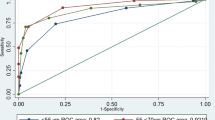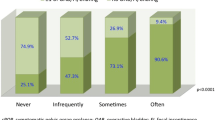Abstract
Introduction and Hypothesis
Pelvic organ prolapse (POP) severity is poorly correlated with prolapse symptoms. The objective of this study was to investigate the association between genital hiatus (GH) size and presence and severity of bulge symptoms.
Methods
This analysis utilized data from a longitudinal study of parous women. Women underwent annual assessment of POP, GH size, and bulge symptoms. “Bother” was scored by participants reporting bulge symptoms. Three analyses evaluated the association between GH size and bulge symptoms, each using linear mixed models. First, we compared case visits (bulge symptoms reported) to control visits (bulge symptoms never reported), matching for stage. Second, among women who reported bulge sensation at least once during the study, we compared GH size at visits with and without bulge symptoms. Third, among women who reported bulge sensation, we investigated whether GH size was associated with “bother” score, controlling for stage.
Results
Of 1528 women (7440 visits), 148 women (803 visits) reported bulge symptoms at ≥ 1 visit and 1380 women never reported bulge symptoms (6637 visits). Comparing 315 case visits (bulge symptoms reported) to 1260 control visits (bulge symptoms never reported), GH size was significantly greater among case visits (3.05 cm versus 2.85 cm, p ≤ 0.0001). In the case-crossover analysis, GH size was similar for visits with and without bulge symptoms (p = 0.63). When evaluating GH size and degree of bulge symptom bother, bother severity was significantly associated with GH size (p = 0.003).
Conclusions
Independent of stage, GH size was significantly associated with prolapse bulge symptoms and bother severity.

Similar content being viewed by others
References
Barber M, Walters M, Bump R. Association of the magnitude of pelvic organ prolapse and presence and severity of symptoms. Jrnl of Pelvic Med & Surg. 2003;9:208.4. Swift S, Woodman P, O’Boyle A, Kahn M, Valley M, Bland D, et al. Pelvic organ support study (POSST): the distribution, clinical definition, and epidemiologic condition of pelvic organ support defects. Am J Obstet Gynecol. 2005;192:795–806.
Barber MD. Symptoms and outcome measures of pelvic organ prolapse. Clin Obstet Gynecol. 2005;48:648–61.
Barber MD, Brubaker L, Nygaard I, et al. Defining success after surgery for pelvic organ prolapse. Obstet Gynecol. 2009;114(3):600–9.
Blomquist JL, Muñoz A, Carroll M, Handa VL. Association of delivery mode with pelvic floor disorders after childbirth. JAMA. 2018;320(23):2438–47.
Bradley CS, Zimmerman MB, Wang Q, et al. Vaginal descent and pelvic floor symptoms in postmenopausal women: a longitudinal study. Obstet Gynecol. 2008;111(5):1148–53.
Bump RC, Mattiasson A, Bø K, et al. The standardization of terminology of female pelvic organ prolapse and pelvic floor dysfunction. Am J Obstet Gynecol. 1996;175(1):10–7.
DeLancey JO. Anatomic aspects of vaginal eversion after hysterectomy. Am J Obstet Gynecol. 1992;166:1717–24.
Delancey JO, Hurd WW. Size of the urogenital hiatus in the levator ani muscles in normal women and women with pelvic organ prolapse. Obstet Gynecol. 1998;91:364–8.
Handa VL, Blomquist JL, Carroll M, Roem J, Muñoz A. Longitudinal changes in the genital hiatus preceding the development of pelvic organ prolapse. Am J Epidemiol. 2019;188(12):2196–201.
Handa VL, Blomquist JL, Knoepp LR, Hoskey KA, McDermott KC, Muñoz A. Pelvic floor disorders 5–10 years after vaginal or cesarean childbirth. Obstet Gynecol. 2011;118:777–84.
Handa VL, Blomquist JL, Roem J, Muñoz A. Longitudinal study of quantitative changes in pelvic organ support among parous women. Am J Obstet Gynecol. 2018;218(3):320.e1–7.
Lowder J, Oliphant S, Shepherd J, et al. Genital hiatus size is associated with and predictive of apical vaginal support loss. Am J Obstet Gynecol. 2016;214(6):718.e1–8.
Lukacz ES, Lawrence JM, Buckwalter JG, Burchette RJ, Nager CW, Luber KM. Epidemiology of prolapse and incontinence questionnaire: validation of a new epidemiologic survey. Int Urogynecol J Pelvic Floor Dysfunct. 2005;16(4):272–84.
Slieker-ten Hove MCP, Pool-Goudzwaard AL, Eijkemans MJC, et al. Symptomatic pelvic organ prolapse and possible risk factors in a general population. Am J Obstet Gynecol. 2009;200:184.e1–7.
Swift SE, Tate SB, Nicholas J. Correlation of symptoms with degree of pelvic organ support in a general population of women: what is pelvic organ prolapse? Am J Obstet Gynecol. 2003;189:372–7.
Role of the funder/sponsor
The funder had no role in the design and conduct of the study; collection, management, analysis, and interpretation of the data; preparation, review, or approval of the manuscript; and decision to submit the manuscript for publication.
Funding
This study was funded by grants R01HD082070 and R01HD056275 from Eunice Kennedy Shriver National Institute of Child Health and Human Development.
Author information
Authors and Affiliations
Contributions
KS Muñiz: Project development, Manuscript writing/editing.
K Voegtline: Data analysis, Manuscript writing/editing.
S Olson: Data analysis, Manuscript writing/editing.
V Handa: Project development, Data collection, Manuscript writing/editing.
Corresponding author
Ethics declarations
Conflict of interest
None.
Additional information
Publisher’s note
Springer Nature remains neutral with regard to jurisdictional claims in published maps and institutional affiliations.
Rights and permissions
About this article
Cite this article
Muñiz, K.S., Voegtline, K., Olson, S. et al. The role of the genital hiatus and prolapse symptom bother. Int Urogynecol J 32, 829–834 (2021). https://doi.org/10.1007/s00192-020-04569-x
Received:
Accepted:
Published:
Issue Date:
DOI: https://doi.org/10.1007/s00192-020-04569-x




